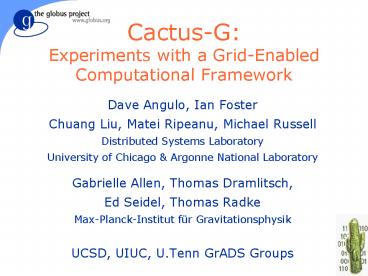Cactus-G: Experiments with a Grid-Enabled Computational Framework - PowerPoint PPT Presentation
Title:
Cactus-G: Experiments with a Grid-Enabled Computational Framework
Description:
Tequila Thorn Functions. Initiate adaptation on any one of. User ... Tequila thorn: monitoring, selection, control. ResourceSelector (via ClassAd protocol) ... – PowerPoint PPT presentation
Number of Views:21
Avg rating:3.0/5.0
Title: Cactus-G: Experiments with a Grid-Enabled Computational Framework
1
Cactus-GExperiments with a Grid-Enabled
Computational Framework
- Dave Angulo, Ian Foster
- Chuang Liu, Matei Ripeanu, Michael Russell
- Distributed Systems Laboratory
- University of Chicago Argonne National
Laboratory - Gabrielle Allen, Thomas Dramlitsch,
- Ed Seidel, Thomas Radke
- Max-Planck-Institut für Gravitationsphysik
- UCSD, UIUC, U.Tenn GrADS Groups
2
Overview
- Research goals Why Cactus-G
- Context Numerical relativity, Cactus, dynamic
Grid computing - The Cactus-G Grid-enabled framework
- Cactus and GrADS
- The Cactus Worm model problem
- Dynamic resource selection code migration
- Experimental results
- Future directions lessons learned
3
Research Goals
- Investigate methods and structures for efficient
Grid execution via in-depth study of a demanding
application, including - Constructs for adapting to heterogeneity
- Constructs for dynamic resource acquisition
- Create testbed for GrADSoft components, as they
emerge - Investigate utility of computational frameworks
as facilitator of Grid computing
4
Context (1)Numerical Relativity
- Numerical simulation of extreme astrophysical
events colliding black holes, neutron stars,
etc. - Understand physics
- Predict gravitational wave forms
- Relativistic effects gt Einstein eqns
- Computationally intensive (can be 1000s
flops/grid point) - 3-D simulations only recently possible demanding
users
Colliding black holes
LIGO gravitational wave observatory
5
Context (2) Cactus(Allen, Dramlitsch, Seidel,
Shalf, Radke)
- Modular, portable framework for parallel,
multidimensional simulations - Construct codes by linking
- Small core (flesh) mgmt services
- Selected modules (thorns) Numerical methods,
grids domain decomps, visualization and
steering, etc. - Custom linking/configuration tools
- Developed for astrophysics, but not
astrophysics-specific
Thorns
Cactus flesh
6
Context (3)Dynamic Grid Computing
- Application behaviors in a Grid environment
- Identify fastest/cheapest/biggest resources
- Configure for efficient execution
- Detect need for new resources or behaviors (e.g.,
due to resource slowdown, new subtasks, new appln
regime, user steering, new resource available) - Adapt, and/or discover new resources invoke
subtasks on new resources and/or migrate - We have users who want these behaviors we also
have the enabling machinery
7
Cactus-G An ApplicationFramework for Dynamic
Grid Computing
- Cactus thorns for active management of
application behavior and resource use - Heterogeneous resources, e.g.
- Irregular decompositions
- Variable halo for managing message size
- Msg compression (comp/comm tradeoff)
- Comms scheduling for comp/comm overlap
- Dynamic resource behaviors/demands, e.g.
- Perf monitoring, contract violation detection
- Dynamic resource discovery migration
- User notification and steering
8
Cactus-G ExampleTerascale Computing
- Solved EEs for gravitational waves (real code)
- Tightly coupled, communications required through
derivatives - Must communicate 30MB/step between machines
- Time step take 1.6 sec
- Used 10 ghost zones along direction of machines
communicate every 10 steps - Compression/decomp. on all data passed in this
direction - Achieved 70-80 scaling, 200GF (only 14 scaling
without tricks)
9
Cactus-G Model ProblemThe Cactus Worm
- Migrate to faster/ cheaper system
- When better system discovered
- When requirements change
- When characteristics change (e.g., competition)
- Tests most elements of Cactus-G GrADS
10
Cactus Worm Architecture
GrADS Mechanisms
Resource selector
Application manager
Globus Toolkit substrate resource discovery,
allocation, management
11
Tequila Thorn Functions
- Initiate adaptation on any one of
- User request (e.g., HTTP thorn)
- Notification of new resources
- Application monitoring contract violation
- Request resources (ClassAd protocol)
- E.g., GrADS ResourceSelector
- Checkpoint application
- Contact App Manager to request restart
- Security, robustness advantages vs. direct restart
12
Cactus WormDetailed Architecture Operation
Application Manager
Compute resource
Compute resource
Appln other thorns
Cactus flesh
Tequila Thorn
Storage resource
GrADS Resource Selector
Storage resource
Code repository
Grid Information Service
Code repository
13
Contract Monitor
- Driven by three user-controllable parameters
- Time quantum for time per iteration
- degradation in time per iteration (relative to
prior average) before noting violation - Number of violations before migration
- Potential causes of violation
- Competing load on CPU
- Computation requires more processing power e.g.,
mesh refinement, new subcomputation - Hardware problems
14
Current Status
- We have developed
- Tequila thorn monitoring, selection, control
- ResourceSelector (via ClassAd protocol)
- Cactus performance model
- We have demonstrated on GrADS Macro Grid
- Contract monitoring for multiprocessor runs
- Dynamic resource selection
- Migration
15
Migration in Action
16
Ongoing and Future WorkNew and Improved
Capabilities
- Optimize migration process
- Use performance models during selection
- And include cost of migration information about
future computation in the model - Matchmaker-based ResourceSelector
- Separation of concerns between resource
characterization and selection - Study resource characterization process, use
NWS-based prediction techniques - Dynamic notification of availability of better
resources
17
Ongoing and Future WorkFurther Integration with
GrADSoft
- Contract monitoring
- Pablo
- Issues determining which thorns are monitored,
or if flesh is monitored - Program Preparation System
- Configurable Object Program and Application
Launcher - Cactus has its own launcher and compiles its own
code
18
Lessons Learned and Outcomes
- Lessons learned
- A real demanding application can exploit
adaptive techniques to execute efficiently in
Grid environments - Even a relatively regular application can
incorporate a range of useful mechanisms for
adaptive behaviors resource demands - Outcomes
- Prototype Cactus-G framework wonderful
experimental platform































